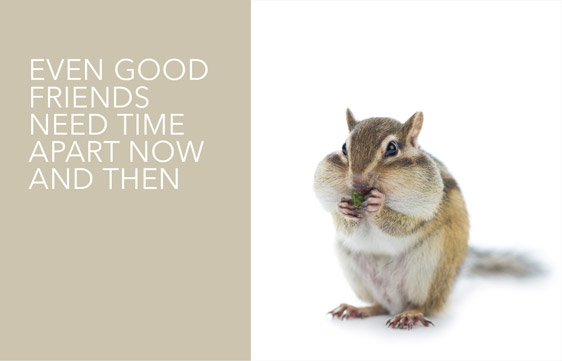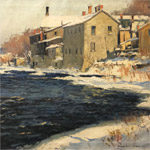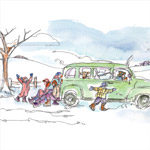
Even good friends need time apart now and then
CHIPMUNKS STARTED PREPARING FOR WINTER SOME WEEKS AGO. As much as I enjoy watching their antics as they dart around my backyard in their designer coats, I’m happy to see these marauding little mammals head into their burrows for their winter naps. This past gardening season, they cleaned me out of hollyhocks, marigolds and red peppers and then they totalled my meagre crop of carrots. Yes, I need a break from them!
Prior to the winter, the eastern chipmunk’s heart races at a brisk 350 beats per minute. But when the cold weather arrives, this perky little fellow undergoes a remarkable transformation. Safe in its burrow during the winter months, its heart rate drops into a whisper mode – a modest four beats per minute – just enough to keep it alive. Its body temperature chills from 36°C to just 3°C. But every two weeks, it wakes up to have a snack of its cached food supply – probably nibbling on the seeds it stole from my bird feeder in the summer – and it will also take advantage of the opportunity to urinate in a special chamber reserved for that occasion. During this awake time, it staggers around with its eyes closed, grabs a bite to eat, then curls up and snoozes away for another 15 day cycle. By April, it springs to life with renewed vigour.
The chipmunk is often cited as a hibernator, but technically speaking, it’s not. True hibernators enter a prolonged state of torpor through the entire winter. There are very few mammals that sleep non-stop because it’s far too risky. Most move around periodically.
Chipmunks don’t have to check their calendar to prepare for the cold. It is second nature to them. Their survival instincts are triggered by the photoperiod, when days become shorter and the temperature drops. But there are always exceptions to the rules. As anyone who operates a bird feeder knows, a few brave chipmunks will remain somewhat active through the winter months if there is a ready supply of food.
In reality, we don’t need to worry much about our wildlife companions during the long, dark days of winter. Thousands of years of adaptation and evolution ensure their survival. That said, I can’t help but marvel at the tiny chipmunk’s ability to endure the cold. But experience tells me that after their long winter’s nap, my six resident marauders will be gnawing away at my marigolds and hollyhocks again come spring.
Story by:
Terry Sprague




